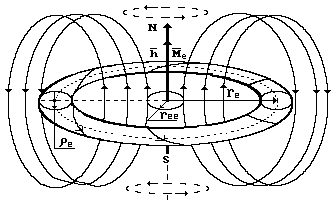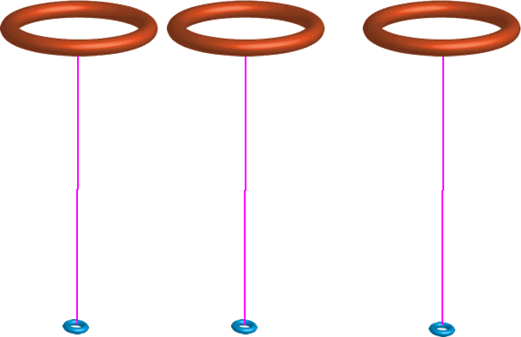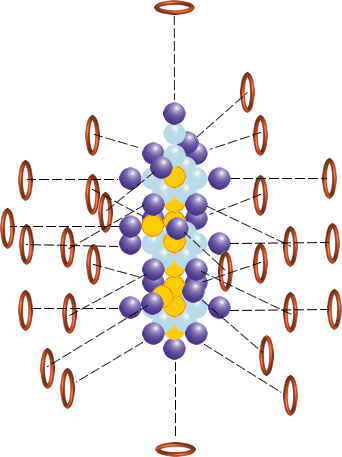Vladi S. Travkin, 
 Natalya N. Bolotina
Natalya N. Bolotina 

The Annals of Exploratory Science
Vladi S. Travkin, 
 Natalya N. Bolotina
Natalya N. Bolotina 


 Hierarchical Scaled Physics and Technologies (HSPT), Rheinbach, Germany,
Denver, CO, USA
Hierarchical Scaled Physics and Technologies (HSPT), Rheinbach, Germany,
Denver, CO, USA

 University of Applied Sciences, Rheinbach, Germany
University of Applied Sciences, Rheinbach, Germany
up to
INTRODUCTION
To move iron (26th element of the table of chemical elements) to this advanced place here in the HS particle physics (HSPP) importance list we have been guided by the desire to disclose some knowledge in HSPP regarding the underlying magnetism phenomena.
The magnetism in physics and related to it phenomena are the great area where the homogeneous outdated notions, ideas hang as a curtain before the public eyes in general and for professional physicists in particular.
The problem, as we wrote in some chapters (sub-sections) of this website and elsewhere, is that the definitions of homogeneous atomic and particle physics cannot be connected to the experimentally obtained (for example, hard drives, microelectronic devices) definitions and device advanced features of magnetism based technologies.
Oh, yes, somehow COHP physicists had managed to connect these fields, but that is the issue of coefficients used, not physics.
The topics of preference here should be the Magnet Motors (either pure MM or electrically assisted MM), the magnetism phenomena themselves, some important biological phenomena.
We spent some substantial effort in an attempt to introduce the scaled magnetism in the 90s and in the 2013 particular at winter and spring time. Hardly a great number of people understood - Why these motors are turning even?
MM of M.Yildiz design deserve much more attention and recognition. The problem is that orthodox physicists in EU and elsewhere are the blocking rock for the MM technology advancing - at least in the ideology, physical theory.
That is why we decided to disclose the picture and phenomena of magnetism from the Bottom (at the sub-atomic scale) and Up to the Continuum Mechanics scales of the MM (and of other magnetism technologies) with the methods of HSP-VAT and Ht Continuum Mechanics.
We would like to start with the description of electron and some atoms when the electron is not the point-mass mythical particle, and when the atom has a structured nucleus and physically explained structure of electron's array of the atom.

Electron in 3D - shown without the surficial movements and magnetic momentum and a spin, that is following.

Electron in an aether - Kanarev, Ph.M.

Proton in 3D - without its magnetic momentum and surface dynamics.

Hydrogen atoms - not a correct scale used in a figure, otherwise it will go beyond the page.

Iron element (Ferrum) nucleus in 3D (of the Fe

 isotope) - shown here without magnetic momentum and
surface dynamics of nucleons.
isotope) - shown here without magnetic momentum and
surface dynamics of nucleons.


Nuclei as they draw them in Conventional Orthodox Homogeneous nuclear physics; http://ie.lbl.gov/education/isotopes.htm. By the way - the gamma rays shown up in the picture are not the "rays" or "waves," nonetheless are the fluxes of photons (particles) that may be depicted mathematically (only mathematically) as the "electromagnetic waves". That means the image of gamma particles emitted should be better represented as the cloud or few gamma photons.
In COH nuclear physics they draw nuclei in the same mode as in COH chemistry - close packing of balls (nucleons) with no regard of how they interact at least graphically - and no surface dynamics and magnetism, but "nuclear forces." We will return to these issues in Nuclear Physics Ht 2P.

Ferrum (Lat.) atom - not a correct scale used in a figure regarding the sizes of electrons and the distances, otherwise it will go beyond the page. Shown first time in publication, not depicted even in Ph.M. Kanarev's works. This theory and model for Fe has some discrepancies with Kanarev's narrative.
There is no circling of electrons around of nucleus. It was the fairy tale of 1910-1920s and beyond.
This description gives the ability to theorize and model the electromagnetic fields of the atom. There is no direct need to turn to the mathematical equation of Schredinger. There is no need for abandoning the direct assessment and evaluation of EM fields.
The EM fields inside and around of atom have the governing equations and an atom itself as well.
The structure of atomic EM fields is following the structure of atom's nucleus and of the nucleons and electron's energy distributions. Then only we obtain the ability to talk and model the magnetic fields of an atom and of the array of atoms in the aether. This task is not possible to perform in the COH physics, because COHP is not able to do the local-nonlocal interaction, and the averaging of the processes.

Iron's atom presentation in Wikipedia.

Pseudo-explanation of the magnetism phenomena in COHP.

Another pseudo-explanation of electrons magnetic momentum alignment as for the magnetism phenomena in COHP.
These figures from Wikipedia (summarizing other COHP pictures) and from many other sources, textbooks that supposed to teach students on fundamental questions in physics and chemistry, but they don't.
Well, extremely important is that in all above figures of COH physics shown the incorrect physically entity of the surrounded arrays of objects. This kind of averaging is incorrect, and the large number of papers, texts was written on this issue.
Finally, in this scale related HSP treated way we can come up with the modeling magnetic phenomena of the piece of an iron where all the EM fields of electrons, protons are interconnected and averaged (summed up) correctly for making the bulk magnetic fields. We are not dealing with the pictures of imaginable electron's circling around the nuclei, but with the averaging of the magnetic fields of each electron and atom - with their spatial structure and the Maxwell-Heaviside-Lorentz or/and Galilean electrodynamics of Klyushin, Ja.G., for making a scaleportation of EM fields between the sub-atomic and micro-mechanics scales.
The second very important issue regarding the iron atom (and its isotopes) correct model is its role in such a critically important macromolecules as Hemoglobin and Myoglobin (figures from internet):

Hemoglobin macromolecule with the heme parts.

Hemoglobin macromolecule showing bonding as sticks.

Myoglobin molecule presentation in COH biochemistry.
It is well known that in the central parts of both hemoglobin's and myoglobin's chains are located the heme elements - which are themselves the large molecules containing the iron atom (Fe).

As one can see in these graphical schemes above, the heme molecules have the specific interconnections to the iron atom and polypeptide chains, and these ties even not presented as just the bonding sticks in COH biochemistry?! Which is a kind of fun to observe in it regarding the atomic bonds presentation?
Biochemists don't know - How the Heme atoms are connected to the iron atom and to the polypeptide chains! Exactly and directly? As the hydrogen atoms, molecules connecting via the "CIRCLING ELECTRONS"? How the "CIRCLING ELECTRONS" are able to circle around their own nuclei and at the same time be so clever to find out from the neighboring nuclei the appropriate ones to make a play with them?
Without the supreme forces and MHL electrodynamics it is not imaginable, seems. Unfortunately, neither planetary model nor the MHL electrodynamics were never able to help the similar to this models and simulations. Why is not? Interesting enough. What students should think about this?
Additional note: to understand the approach and methods of HS (hierarchical scaled) physics at atomic and sub-atomic scales used in this chapter (section) readers need to go through some of the already known and published for more than 45 years the ideas, definitions, methods developed and explored in this physics, that is the covering of COHP, such as those mostly relevant to the particle physics and atomic physics.
The strict arguments in a favor of naturally appealing physical disciplines are spelled in our - "Electrodynamics 2":
Some general initial statements and conditions for functioning of sub-atomic physics on the base of physical observation and experiments first of all, we discuss at the introductory to the Polyphase-Polyscale particle physics. As long as the other COHP theories developed for the sub-atomic particles actually support the main assumptions of QM, we won't spend a lot of time on them - because we will need to repeat the arguments already stated in our introductory -
and
and
and
and
Well, this is a lot of content in these articles that is supported by many facts, including experimental, and theories.
1. Kanarev, Ph.M., "A Model for the Free Electron," Galilean Electrodynamics, Vol. 13, No. S1, pp. 15-18, (2002)
2. Kanarev, Ph.M., Photon, http://www.micro-world.su/ Folder "Books"; retrieved 05/05/2013
3. Kanarev, Ph.M., Nuclei of Atoms, http://www.micro-world.su/ Folder "Books"; retrieved 05/05/2013
4. Kanarev, Ph.M., Answers to Microworld Questions, http://www.micro-world.su/ Folder "Answers"; retrieved 05/05/2013
5. Kanarev, Ph.M., Introduction to New Electrodynamics, http://www.micro-world.su/ Folder "Books"; retrieved 05/05/2013
6. Kanarev, Ph.M. , The Foundations of Physchemistry of Microworld. Monograph. The 15th edition, http://www.micro-world.su/index.php/2010-12-22-11-45-21/139--i; retrieved 05/05/2013
7. Travkin, V. S., "What are the basics of HSP-VAT Physics in Heterogeneous Media?," http://travkin-hspt.com/fundament/02.htm, (2002)
8. Travkin, V. S., Electrodynamics 2 - Elements 3P (Polyphase-Polyscale-Polyphysics), http://travkin-hspt.com/eldyn2/index.htm, (2013)
9. Travkin, V. S., Fundamentals of Scaling Heterogeneous Science, http://travkin-hspt.com/fundament/index.htm, (2002)
10. Travkin, V. S. and Bolotina, N.N., Biology and Ecology as Hierarchical, Heterogeneous, Multiscale Sciences and their Applications, http://travkin-hspt.com/bio/index.htm, (2005)
11. Travkin, V. S. and Bolotina, N.N., Cellular Biology HS, http://travkin-hspt.com/biocell/index.htm, (2005)
12. Travkin, V. S. and Bolotina, N.N., Heterogeneous Scaled Biophysics (HtScBp). Fundamentals, http://travkin-hspt.com/biophysics/index.htm, (2009)
13. Travkin, V. S., "Magnetism. Ferromagnetism," http://travkin-hspt.com/fermag/index.htm, (2003-2009)
14. Travkin, V. S., Solid State Polyscale Physics, Fundamentals **, http://travkin-hspt.com/solphys/index.htm, (2009)
15. Travkin, V.S. and Catton, I., Transport Phenomena in Heterogeneous Media Based on Volume Averaging Theory, in Advances in Heat Transfer, New York, Academic Press, Vol. 34., pp.1-144, (2001)
16. Travkin, V. S. and Bolotina, N.N., "Quantum Chemistry, Physical Chemistry, Molecular Dynamics Simulation, DFT (Density Functional Theory), and Coarse-Graining Techniques Applied in Structural, Cellular Biology, Polymer Science and Implication for Scaleportation," Journal of Alternative Energy and Ecology, No. 2, pp. 58-75, (2011a)
17. Travkin, V. S. and Bolotina, N.N., "Pseudo-Scaled and Scaled Description and Scaleportation of Inorganic and Organic Polymer and Polymer Composites Properties," Journal of Alternative Energy and Ecology, No. 1, pp. 62-77, (2011b)
18 Travkin, V.S., Statistical Mechanics Homogeneous for Point Particles. What Objects it Articulates? http://travkin-hspt.com/statmech/index.htm, (2014)
19. Travkin, V.S., Solid State Polyscale Physics. Fundamentals, http://travkin-hspt.com/solphys/index.htm, (2014)
The following material will describe and explain in more or less simple text the scaled subjects regarding Iron as a solid state, porous medium (at moderate temperatures and pressure):
Access to manuscript may be obtained for qualified parties. Apply for authorization.
===========================================================================
Almost any information displayed here is the proprietary information in the area of "Iron in HS Physics".
This is also the well known problem - still can not be resolved within the Homogeneous One-Scale particle physics, atomic physics, chemistry theories.
![]()

![]()